If you’re choosing between Home Assistant and SmartThings for appliance control, consider how much customization and control you want. Home Assistant offers more flexibility with local device support and complex automations, but it can be tricky to set up. SmartThings provides easier installation and a user-friendly interface, with reliable cloud-based control. Both work with voice assistants, but your choice depends on whether you prefer simplicity or advanced personalization. Keep exploring to find the best fit for your smart home needs.
Key Takeaways
- Home Assistant offers extensive device support and local control, ideal for custom appliance automation and privacy-conscious setups.
- SmartThings provides a user-friendly setup and app-based routines, suitable for quick and simple appliance control.
- Home Assistant’s advanced customization enables complex automations for appliances, while SmartThings focuses on straightforward routines.
- SmartThings relies on cloud services, which may introduce privacy concerns, whereas Home Assistant emphasizes local device management.
- Scalability in Home Assistant is more flexible for larger setups, while SmartThings may require additional hubs for extensive appliance networks.
Compatibility With Devices and Appliances
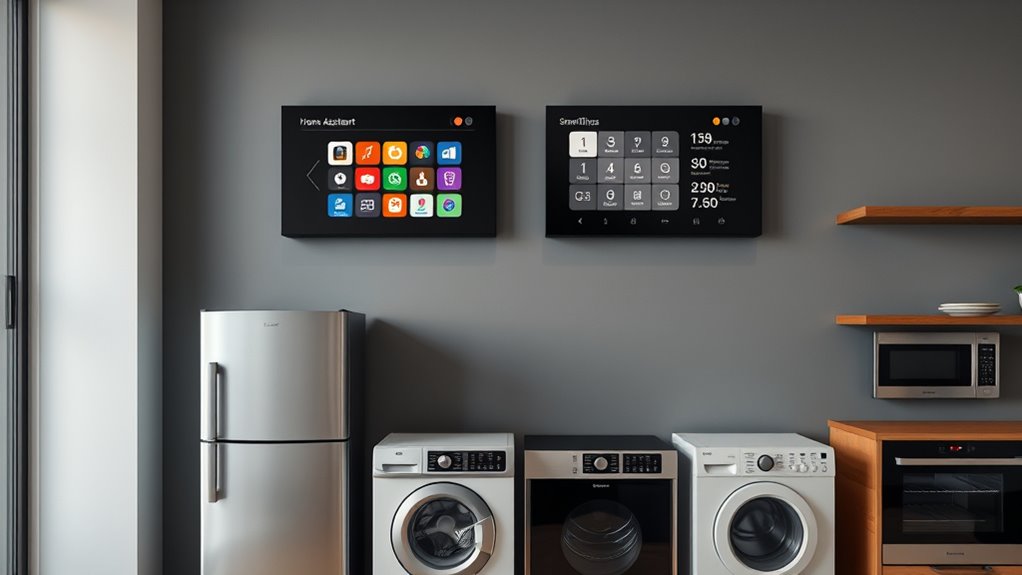
When choosing between Home Assistant and SmartThings, compatibility with your devices and appliances is a key factor. Home Assistant offers broad support for a wide range of devices, including custom integrations and open-source options. If your gadgets are from various brands or older models, Home Assistant might handle them more effectively. Additionally, device compatibility is continually evolving, and Home Assistant’s community-driven updates often lead to quicker support for new or niche products. The platform’s protocol support includes Zigbee, Z-Wave, and Wi-Fi, which enhances its ability to connect with diverse devices. Furthermore, Home Assistant’s open-source nature allows for custom integrations, making it highly adaptable to unique or specialized appliances. The interoperability between different protocols and brands is often superior, giving users more flexibility in device choices. SmartThings, on the other hand, is optimized for Samsung devices but also supports many popular brands through Zigbee, Z-Wave, and Wi-Fi. However, compatibility can sometimes be limited with niche products or less common protocols. Consider the ecosystem of your current devices before deciding. If seamless integration across diverse brands matters most, Home Assistant’s flexibility could be advantageous. Conversely, if your devices align well with SmartThings’ supported list, it might be the more straightforward choice. Additionally, the growing focus on device compatibility in the industry influences how well these platforms integrate with emerging and legacy smart devices.
Ease of Setup and User Interface
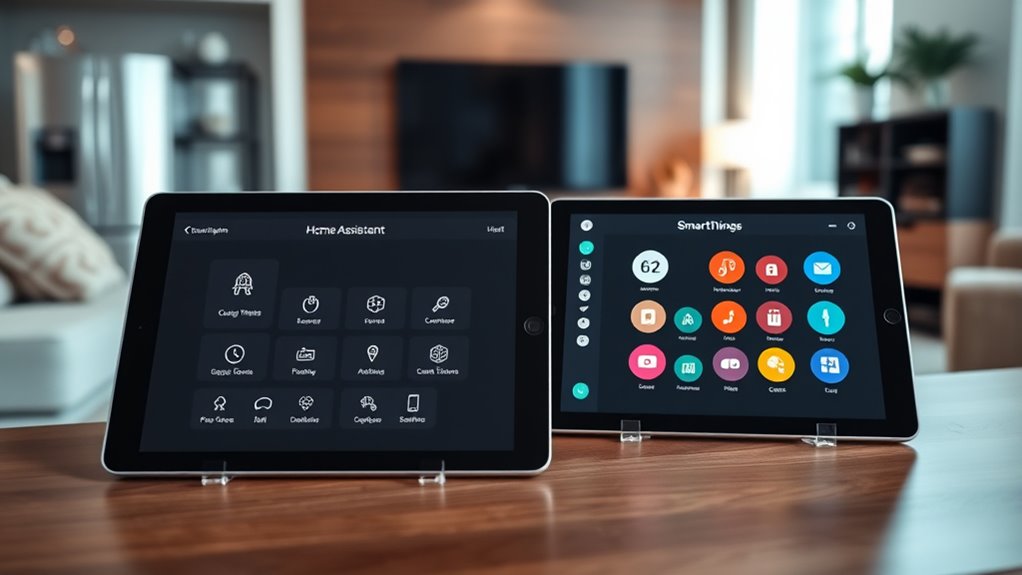
Setting up your smart home should be straightforward, but the process varies between platforms. Home Assistant often requires more technical steps, while SmartThings offers a simpler, guided setup. Steering through the user interface quickly impacts how easily you can manage your devices and customize your system. Additionally, understanding the principles of resilience and emotional control from Stoicism can help users approach troubleshooting and system adjustments with patience and clarity. Familiarity with user-friendly interfaces can further enhance your experience, making device management more intuitive and less stressful. Recognizing the importance of proper configuration ensures smoother integration and ongoing system stability, especially when embracing a holistic approach to managing your smart home ecosystem. Being aware of regional resources can also provide additional support and guidance during setup and troubleshooting.
Setup Process Complexity
Home Assistant offers a highly customizable setup process that can be challenging for beginners, requiring you to install and configure software on a local server or Raspberry Pi. You’ll need to download the software, set up dependencies, and handle network configurations, which can be overwhelming if you’re unfamiliar with technical tasks. The process involves editing configuration files and troubleshooting issues, demanding patience and some technical knowledge. Unlike cloud-based options, you won’t find a simple installer or guided setup. This complexity allows for extensive customization but can slow down initial setup if you’re new to home automation. Expect a steeper learning curve, especially if you prefer a plug-and-play experience. Overall, it’s powerful but demands effort and technical confidence to get everything running smoothly. Additionally, understanding configuration management is crucial for effectively customizing and maintaining your setup. Exploring user-friendly interfaces can help ease the learning process, especially for those unfamiliar with home automation systems. Furthermore, the integration of advanced automation technologies can enhance functionality once the initial setup is complete.
Interface Navigation Ease
Home Assistant’s interface can be quite intimidating for newcomers. Its layout is dense, and navigation isn’t always intuitive. You might find yourself clicking through multiple menus to locate simple controls or settings. You may also encounter a steep learning curve, which can be a barrier to effective use. Additionally, understanding the various dog breeds involved in device customization can be complex for beginners. Moreover, the technology used in home automation systems influences how easily users can adapt to different interfaces. SmartThings offers a more streamlined experience, with a user-friendly dashboard that makes device management straightforward. To help you compare, here’s a quick overview:
| Aspect | Home Assistant | SmartThings |
|---|---|---|
| Setup Navigation | Complex, requires familiarity | Simple, guided interface |
| Customization Flexibility | Highly customizable, can be overwhelming | Limited but more intuitive |
| User Interface Design | Functional but dense | Clean, modern, easy to navigate |
| Learning Curve | Steep initially | Gentle learning curve |
Customization and Automation Capabilities
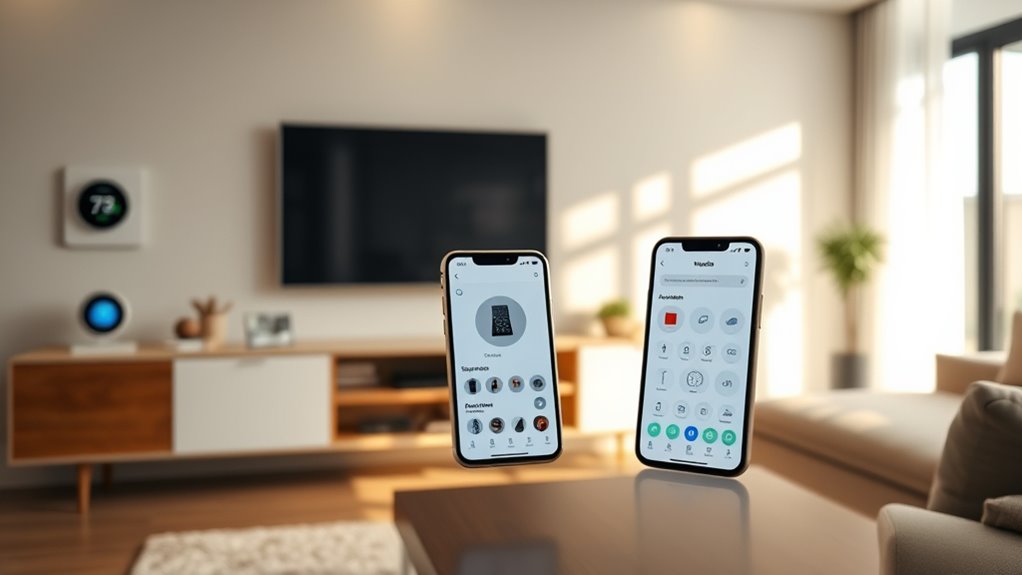
When it comes to customization and automation, both Home Assistant and SmartThings offer powerful features, but they approach these capabilities differently. With Home Assistant, you gain extensive flexibility through customizable scripts, YAML configurations, and a wide range of integrations. It allows you to create complex automations tailored precisely to your needs, even if it requires some technical know-how. SmartThings simplifies automation with a user-friendly app that lets you set up routines and simple triggers without coding. While it may not offer the same depth of customization as Home Assistant, it provides enough options for most users to automate common household tasks easily. Your choice depends on whether you prefer detailed control or straightforward setup, but both platforms excel in automating your smart home.
Integration With Voice Assistants
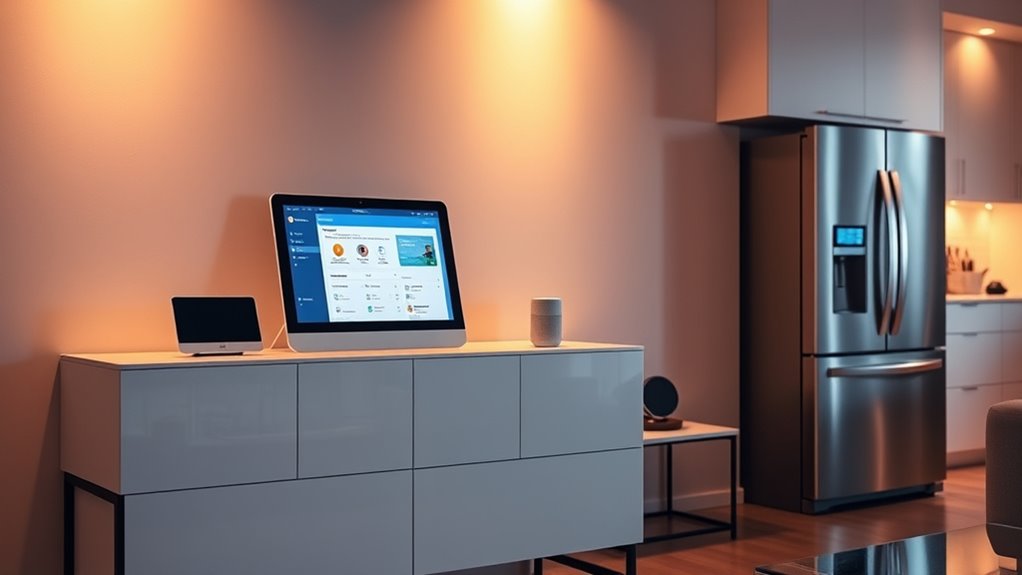
Both Home Assistant and SmartThings support integration with popular voice assistants, making it easy to control your smart devices hands-free. With Home Assistant, you can connect to Alexa, Google Assistant, or Siri, allowing you to issue voice commands that trigger automations or control specific devices. SmartThings also integrates seamlessly with Alexa and Google Assistant, giving you similar voice control capabilities. Setting up these integrations is straightforward—usually involving linking accounts and enabling skills or services. Once connected, you can turn appliances on or off, adjust settings, or activate routines simply by speaking. This integration enhances convenience, enabling quick adjustments without opening apps or interacting directly with devices. Both platforms make voice control accessible, helping you manage your smart home effortlessly.
Security and Privacy Considerations
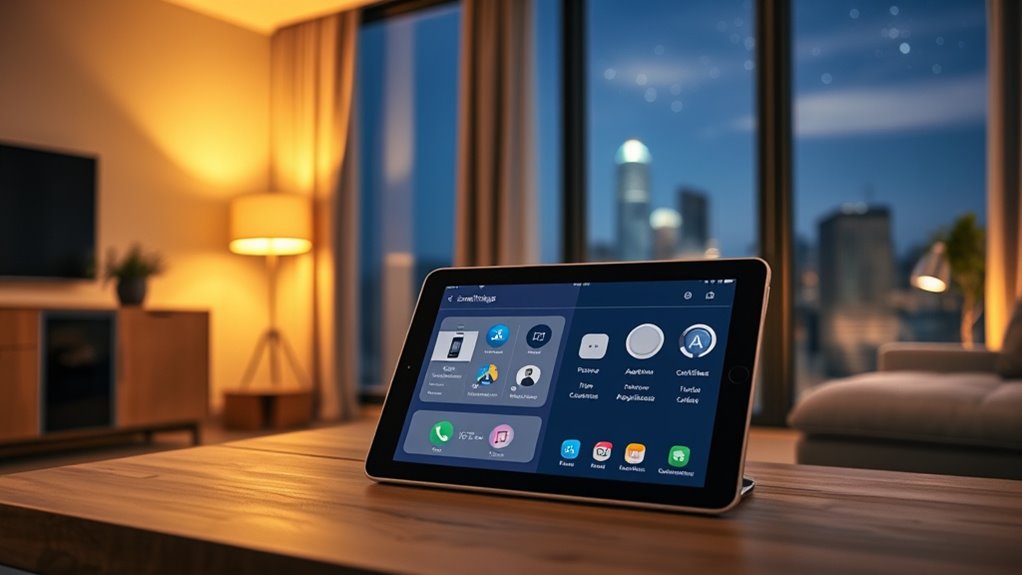
When choosing between Home Assistant and SmartThings, it’s important to contemplate how they handle your data security. You should look at their encryption standards, device authentication methods, and how they manage cloud data. These factors directly impact your privacy and the safety of your smart home setup.
Data Encryption Standards
Data encryption standards are vital for protecting your smart home data from unauthorized access and ensuring your privacy. When you use platforms like Home Assistant or SmartThings, sensitive information such as device statuses, usage patterns, and personal preferences travel across networks. Strong encryption protocols, like AES or TLS, safeguard this data during transmission and storage. If these standards are weak or outdated, hackers could intercept or manipulate your data, risking privacy breaches or unauthorized control. Both platforms should adopt robust encryption methods to shield your information effectively. By understanding and verifying their encryption practices, you can guarantee your smart home remains secure and your personal data stays private. Prioritizing encryption is a critical step in maintaining the integrity of your connected home environment.
Device Authentication Measures
Device authentication measures are essential for ensuring that only trusted devices can access and control your smart home system. By verifying device identities through secure methods like certificates, tokens, or unique cryptographic keys, you prevent unauthorized access. Home Assistant typically relies on local network authentication, requiring devices to authenticate via passwords or API keys. SmartThings, on the other hand, uses cloud-based authentication, where devices authenticate through Samsung’s servers before gaining control. Strong authentication reduces the risk of malicious devices hijacking your system or spying on your activities. Ensuring your devices support robust authentication methods and keeping firmware updated is critical. This way, you protect your smart home from potential security breaches, maintaining privacy and control over your connected appliances.
Cloud Data Management
How your smart home handles cloud data substantially impacts your privacy and security. When your devices send data to the cloud, it’s vulnerable to breaches, unauthorized access, and potential misuse. Home Assistant offers local control options, minimizing cloud reliance, which enhances privacy. SmartThings, however, depends heavily on cloud services, raising concerns about data exposure. To better understand, review the table below:
| Feature | Impact on Privacy & Security |
|---|---|
| Data Storage Location | Local (Home Assistant) vs. Cloud (SmartThings) |
| Data Encryption | End-to-end encryption reduces risk |
| Data Access Controls | User permissions limit data exposure |
| Data Retention Policies | Shorter retention reduces vulnerability |
| Third-party Integrations | Potential for data sharing or leaks |
Knowing these factors helps you choose a system aligned with your privacy priorities.
Cost and Funding Options
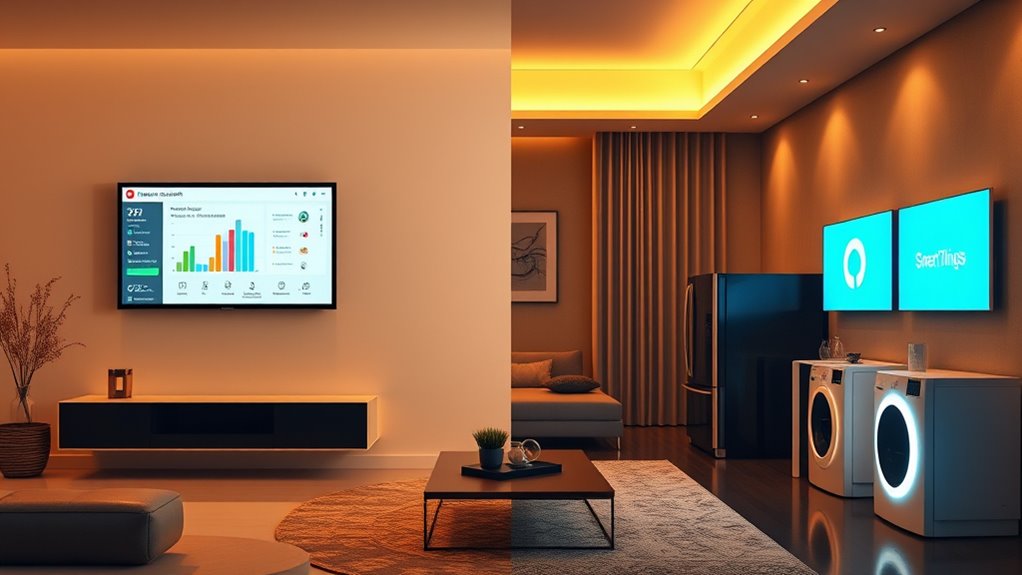
When comparing Home Assistant and SmartThings, understanding the cost and funding options is essential to making an informed decision. Home Assistant is open-source software, so it’s free to download and use, but you’ll need to budget for compatible hardware like a Raspberry Pi or a dedicated server. You might also spend on optional accessories or custom integrations. SmartThings, on the other hand, requires purchasing a hub and compatible devices, which can range from affordable to premium prices. It offers subscription plans for advanced features, but these aren’t mandatory. Your total costs depend on your device choices and whether you prefer a DIY approach or a ready-to-use system. Budgeting for hardware, optional subscriptions, and potential upgrades helps you choose the most cost-effective setup.
Community Support and Development
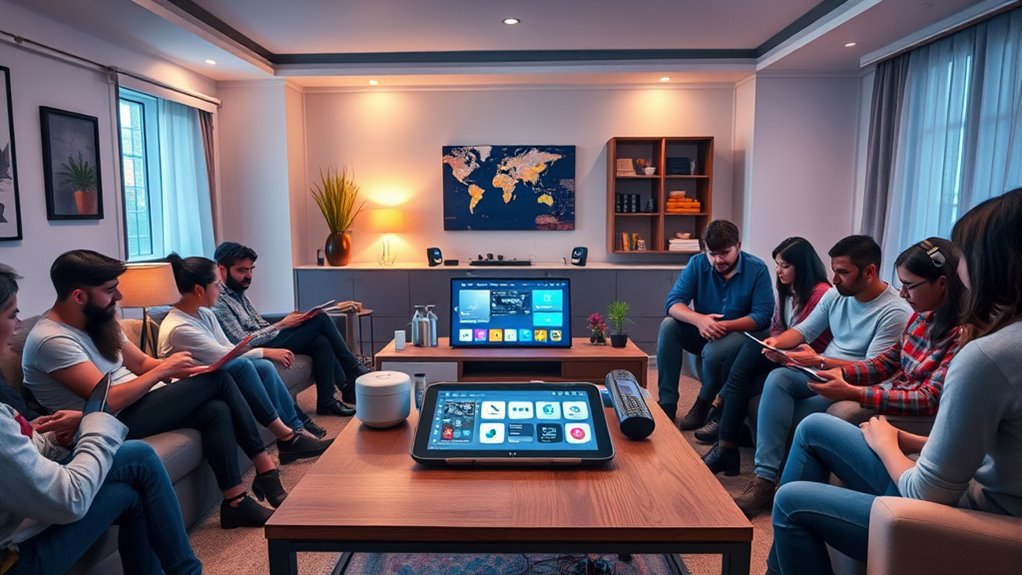
Both Home Assistant and SmartThings benefit from active communities that drive ongoing development and support. With Home Assistant, you’ll find a passionate open-source community constantly creating new integrations, plugins, and customizations. This means you can often find solutions to unique problems and extend functionalities easily. SmartThings also has a large user base, supported by Samsung and a network of third-party developers. While you may encounter official updates and new device integrations, community-driven support is less prominent. Nonetheless, both platforms encourage user contributions, forums, and online resources. Your experience will likely depend on how much you’re willing to engage with these communities. Overall, active community support enhances troubleshooting, innovation, and adaptation, making each platform more robust over time.
Scalability and Future Updates

Scalability and future updates play a crucial role in determining how well your smart home system can grow and adapt over time. With Home Assistant, you benefit from a highly flexible platform that allows you to add new devices and integrations easily, thanks to its open-source nature. It receives frequent community-driven updates, ensuring continuous improvements and new features. SmartThings offers a more streamlined experience, with official support and regular firmware updates, though its device compatibility can be more limited. As your home expands, Home Assistant’s modular architecture makes scaling straightforward, while SmartThings might require additional devices or hubs. Ultimately, if you want a system that evolves with your needs and offers ongoing updates, Home Assistant provides more customization and future-proofing options.
Frequently Asked Questions
Can Both Platforms Support Multi-Room Audio Setups?
Both platforms can support multi-room audio setups, but their capabilities differ. With Home Assistant, you can integrate various smart speakers and synchronize audio across rooms using custom scripts and integrations. SmartThings also supports multi-room audio, especially with compatible Samsung speakers and other brands. You’ll find that both allow you to control and group speakers, but Home Assistant offers more customization options, while SmartThings provides a more straightforward, plug-and-play experience.
Which Platform Offers Better Integration With Third-Party Smart Home Brands?
Imagine your smart home is a bustling marketplace, filled with vendors (brands) offering unique goods. You want a coordinator who can bring together diverse stalls seamlessly. Both platforms aim for this, but Home Assistant often acts like a multilingual guide, supporting a wider array of third-party brands through custom integrations. SmartThings provides a more streamlined experience with popular brands, but Home Assistant offers deeper flexibility for a truly interconnected marketplace.
How Do Updates Affect Existing Device Compatibility?
Updates can impact your device compatibility by introducing new features or fixing bugs, but they may also cause issues with existing devices. You should check release notes before updating, as some updates might temporarily disrupt communication with certain appliances. Staying informed and backing up your setup helps guarantee smooth shifts. Regularly verifying device support after updates keeps your smart home running seamlessly and prevents unexpected disruptions.
Are There Any Hidden Costs for Advanced Automation Features?
When exploring advanced automation features, you might wonder about hidden costs. Typically, these costs include subscription fees for premium services, extra hardware, or third-party integrations that aren’t included in the base system. You should carefully review each platform’s pricing structure and available plans. By doing so, you’ll avoid surprises and guarantee your automation setup stays within your budget while enjoying all the advanced features you desire.
Which Platform Provides Better Customer Support Options?
If you’re counting on superior customer support, you’ll find it’s like finding a needle in a haystack. SmartThings generally offers more direct support options, including phone and live chat, making it easier to get help fast. Home Assistant, being open-source, relies heavily on community forums, which can be slower but often more detailed. So, if quick, reliable support matters most, SmartThings is your best bet.
Conclusion
Choosing between Home Assistant and SmartThings is like picking your trusted compass in a vast smart home ocean. Home Assistant offers a DIY ship ready to customize, while SmartThings is a ready-made vessel guiding you effortlessly. Whichever you steer, your smart home journey will become a seamless dance of convenience and control—turning your house into a harmonious symphony of connected appliances. Set sail confidently and enjoy the smooth sailing ahead!










